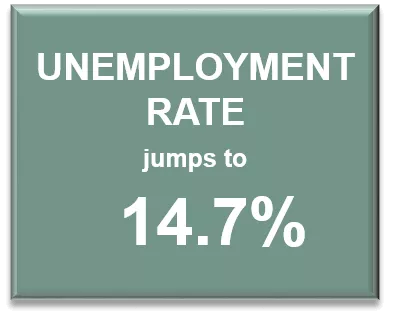May Economic Commentary: The Numbers Begin to Reflect Reality

Chief Economist
Pohlad Companies
The initial monthly government economic reports covering the period since the shutdown of the economy in mid-March have started to be released. First-quarter GDP, April’s employment report, March’s retail sales, Industrial Production, etc., are putting numbers to a picture that everyone knew was going to be historically horrendous. A quick analysis of these reports suggests that any hope of a V-shaped recovery from this sharp decline in economic activity should be taken with a healthy dose of skepticism.
GDP
We can start by looking at the initial release of first-quarter GDP which reported real growth of -4.8% (annualized). Remember that the economic shutdown did not really start in earnest until mid-March. The negative reading for GDP was largely driven by a 7.6% decline in consumer spending. Estimates for second-quarter GDP growth range from -20% to -40%, with consensus around -35%. The economy is expected to improve in the second half of the year, but growth for the entire year is still forecast to be around -6%, which would be the worst yearly GDP growth post-WWII.

Employment Picture
April’s employment report was released on May 8. It showed nonfarm payroll losses of 20.5 million jobs. This loss wipes out the entire gain in employment during the recovery from the financial crisis in 2008-2009. The unemployment rate increased to 14.7%, the highest level since the Great Depression. Average hourly earnings jumped 7.9% year-over-year—an indication that most of the job losses have come from lower-compensated workers. The high level of unemployment will keep wages under negative pressure, however, once the labor market commences recovery.
Initial Jobless Claims peaked in the last week of March and have now declined for five consecutive weeks. This is a sign that the initial economic shock is subsiding. An improvement in Continuing Claims, which are still growing, will likely provide a signal that the economy has started the bottoming process. With Initial Claims still at historically high levels, improvement in Continuing Claims is probably many weeks away.
Since mid-March Initial Jobless Claims have totaled over 33 million. The speed at which the labor market recovers is key to the vibrancy of any overall economic recovery. To that end, the historic expansion of unemployment insurance benefits—namely the extra $600 per week through the end of July—may prove to be counterproductive in getting workers back to their jobs quickly. It is estimated that 65%-75% of workers are receiving more in unemployment benefits than their previous wages as a result of the enhanced unemployment benefits.
Equity Markets
Equity markets appear to be looking past the valley of the recession, focusing on continued monetary and fiscal support as well as hopes for a therapeutic mitigant for the virus. Since bottoming in late March, U.S. equities have rallied more than 30% and recovered 60% of the March decline. The rally, while impressive, has not been broad-based. The five largest stocks in the S&P 500 (MSFT, AMZN, AAPL, GOOGL, FB) are up 6% YTD. The remaining companies in the S&P 500 are down 15% YTD.
What Comes Next
This is first and foremost a health crisis. The timing of a successful reopening of the economy depends on controlling the virus. The U.S. is faced with the confluence of four historic events: the greatest health crisis since the Spanish Flu of 1918, the greatest and swiftest monetary and fiscal intervention in history, the swiftest contraction of the economy since the Great Depression, and the largest and swiftest decline in oil prices ever seen. There are no economic models that can adequately incorporate all of these variables to forecast the length of the economic contraction, its severity, or the vigor of the subsequent recovery. Foreign experience suggests that initial reopening timelines often prove too optimistic, and changes to initial plans have mostly involved moving toward more stringent restrictions and longer lockdowns.
Insights
Research to help you make knowledgeable investment decisions